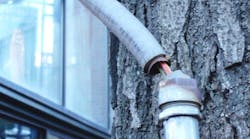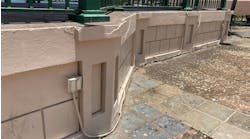How well do you know the Code? Think you can spot violations the original installer either ignored or couldn't identify? Here's your chance to moonlight as an electrical inspector and second-guess someone else's work from the safety of your living room or office. Joe Tedesco, who has a knack for finding shoddy electrical work, did the dirty work and found this mess. Now it's your turn to identify the violation.
Find the Answer
Answer:
Although it is acceptable to run this underground rigid metal conduit up this tree as per 410.16(H) and 300-5(D)(4), the improper support and broken liquidtight flexible metal conduit is a hazard. The separation creates a lost equipment ground, which could allow the equipment on the load end of this circuit to carry electrical current. In turn, this could lead to an electrical shock.
Here are some NEC rules you should be familiar with when using vegetation as a means of support for electrical circuits.
- 225.26 (Services) Vegetation as Support. “Vegetation such as trees shall not be used for support of overhead conductor spans.”
- 230.10 (Services) Vegetation as Support. “Vegetation such as trees shall not be used for support of overhead service conductors.”
-
410.16(H) (Means of Support) Trees. “Outdoor luminaries (lighting fixtures) and associated equipment shall be permitted to be supported by trees.
FPN No. 1: See 225.26 for restrictions for support of overhead conductors.
FPN No. 2: See 300.5(D) for protection of conductors. - 300.5(D)(4) (Underground Installations) Enclosure or Raceway Damage. “Where the enclosure or raceway is subject to physical damage, the conductors shall be installed in rigid metal conduit, intermediate metal conduit, Schedule 80 rigid nonmetallic conduit, or equivalent.”
- 590.4(J) (Temporary Installation) Support. “Cable assemblies and flexible cords and cables shall be supported in place at intervals that ensure that they will be protected from physical damage. Support shall be in the form of staples, cable ties, straps, or similar type fittings installed so as not to cause damage. Vegetation shall not be used for support of overhead spans of branch circuits or feeders.”



